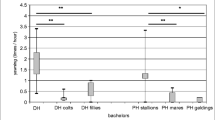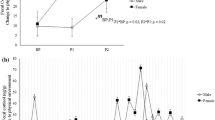Abstract
Previous research on the Assateague horses found that high-ranking females had more surviving offspring than low-ranking females. Variance in reproductive success may be the result of a variety of proximate processes that affect sexual behavior such as mate choice and mate competition. A study was done to determine whether patterns of courtship, social, and sexual behavior could be identified that would suggest mate choice and/or mate competition. Behavioral data were collected from approximately 40 sexually mature mares living in harem bands. Stallions showed more interest in the eliminations of dominant mares than subordinate mares. Males also engaged in significantly more high-intensity (e.g., mounts and copulations) sexual behavior with dominant mares than subordinate mares, and there was a trend for males to engage in more low-intensity (e.g., flehmen and ano-genital sniffing) sexual behavior with dominant mares than subordinate mares. There was no effect of mare rank on spatial relationships with the stallion; however, dominant mares did attempt to restrict reproductive access to the stallion by harassing and disrupting copulations. Higher foaling rates among dominant mares on Assateague Island could therefore be the result of rank-related mate choice by stallions and direct female competition for mating opportunities.



Similar content being viewed by others
References
Ahnesjo I, Vincent A, Alatalo R, Halliday T, Sutherland WJ (1993) The role of females in influencing mating patterns. Behav Ecol 4:187–189
Altmann J (1974) Observational study of behavior: sampling methods. Behaviour 49:227–267
Asa CS, Goldfoot DA, Ginther OJ (1979) Sociosexual behavior and the ovulatory cycle of ponies (Equus caballus) observed in harem groups. Horm Behav 13:49–65
Barnard P, Markus MB (1989) Male copulation frequency and female competition for fertilizations in a promiscuous brood parasite, the pin-tailed whydah (Vidua macroura). Ibis 131:421–425
Bebié N, McElligott AG (2006) Female aggression in red deer: does it indicate competition for mates? Mamm Biol 71:347–355
Bennett NC, Faulkes CG, Jarvis JUM (1999) Socially induced infertility, incest avoidance, and the monopoly of reproduction in cooperatively breeding African mole rats, family Bathyergidae. Adv Study Behav 28:75–114
Berenstain L, Wade TD (1983) Intrasexual selection and male mating strategies in baboons and macaques. Int J Primatol 4:201–235
Berger J (1986) Wild horses of the Great Basin. University of Chicago Press, Chicago
Berger J (1989) Female reproductive potential and its apparent evaluation by male mammals. J Mammal 70:347–358
Berglund A, Rosenqvist G (1993) Selective males and ardent females in pipefishes. Behav Ecol Sociobiol 32:331–336
Berglund A, Magnhagen C, Bisazza A, Konig B, Huntingford F (1993) Female-female competition over reproduction. Behav Ecol 4:184–187
Brandtmann G, Scandura M, Trillmich F (1999) Female-female conflict in the harem of a snail cichlid (Lamprologus ocellatus). Behaviour 136:1123–1144
Bro-Jørgensen J (2002) Overt female mate competition and preference for central males in a lekking antelope. Proc Nat Acad Sci USA 99:9290–9293
Brown JL, Brown ER, Sedransk J, Ritter S (1997) Dominance, age and reproductive success in a complex society: a long term study of the Mexican jay. Auk 114:279–286
Burley N, Moran N (1979) The significance of age and reproductive experience in the mate preferences of feral pigeons, Columba livia. Anim Behav 27:686–698
Bush SL, Bell DJ (1997) Courtship and female competition in the Majorcan midwife toad (Alytes muletensis). Ethology 103:292–303
Clutton-Brock TH, Guinness FE, Albon SD (1982) Red deer: behavior and ecology of two sexes. Univ of Chicago Press, Chicago
Cunningham EJA, Birkhead TR (1998) Sex roles and sexual selection. Anim Behav 56:1311–1321
Darwin C (1871) The descent of man, and selection in relation to sex. Murray Press, London
Derix RRWM, van Hoof JARAM (1995) Male and female partner preferences in a captive wolf pack (Canis lupus): specificity versus spread of sexual attention. Behaviour 132:128–148
Dewsbury DA (1982) Ejaculate cost and male choice. Am Nat 119:601–610
Estes RD (1972) The role of the vomeronasal organ in mammalian reproduction. Mammalia 36:315–341
Estes RD (1991) The behavior guide to African mammals. University of California Press, Berkeley
Frame LH, Malcolm JR, Frame GW, van Lawick H (1979) Social organization of African wild dogs (Lycaon pictus) on the Serengeti plains, Tanzania (1967–1978). Z Tierpsychol 50:225–249
Gwynne DT (1981) Sexual difference theory: Mormon crickets show role reversal in mate choice. Science 213:779–780
Hart BL (1983) Flehmen behavior and vomeronasal organ function. In: Müller-Schwarze D, Silverstein RM (eds) Chemical signals in vertebrates. Plenum Press, New York, pp 87–103
Houpt KA, Keiper R (1982) The position of the stallion in the equine dominance hierarchy of feral and domestic ponies. J Anim Sci 54:945–950
Keiper RR (1985) The Assateague ponies. Tidewater, Centreville, p 185
Keiper R, Houpt K (1984) Reproduction in feral horses: an eight year study. Am J Vet Res 45:991–995
Keiper RR, Sambraus HH (1986) The stability of equine dominance hierarchies and the effects of kinship, proximity, and foaling status on hierarchy rank. Appl Anim Behav Sci 16:121–130
Kirkpatrick JF, Liu IKM, Turner JW Jr, Naugle R, Keiper R (1992) Long-term effects of porcine zona pellucida immunocontraception on ovarian function in feral horses (Equus caballus). J Reprod Fertil 94:437–444
Krebs JR, Davies NB (1987) An introduction to behavioral ecology, 2nd edn. Sinauer, Sutherland, p 257
Lloyd PH, Rasa OAE (1989) Status, reproductive success, and fitness in Cape Mountain zebra (Equus zebra zebra). Behav Ecol Sociobiol 25:411–420
Mackler SF, Dolan JM Jr (1980) Social structure and herd behavior of Equus przewalskii Poliakov, 1881 at the San Diego Wild Animal Park. Equus 2:55–69
Milner-Gulland EJ, Bukreeva OM, Coulson T, Lushchekina AA, Kholodova MV, Bekenov AB, Grachev IA (2003) Reproductive collapse in saigo antelope harems. Nature 422:135
Nakamura M (1998) Multiple mating and cooperative breeding in polygynandrous alpine accentors. I. Competition among females. Anim Behav 55:259–275
Niemeyer CL, Anderson JR (1983) Primate harassment of matings. Ethol Sociobiol 4:205–220
Pluháček J, Bartoš L, Čulík L (2006) High-ranking mares of captive plains zebra Equus burchelli have greater reproductive success than low-ranking mares. Appl Anim Behav Sci 99:315–329
Powell DM (1999) Preliminary evaluation of porcine zona pellucida (PZP) immunocontraception for behavioral effects in feral horses (Equus caballus). J Appl Anim Welf Sci 2:321–335
Powell DM (2000) Evaluation of effects of contraceptive population control on behavior and the role of social dominance in female feral horses, Equus caballus. PhD Thesis, University of Maryland, College Park
Powell DM, Monfort SL (2001) Assessment: effect of porcine zona pellucida (PZP) immunocontraception on estrous cyclicity in feral horses. J Appl Anim Welf Sci 4:271–284
Preston BT, Stevenson IR, Pemberton JM, Wilson K (2001) Dominant rams lose out by sperm depletion. Nature 409:681–682
Rabb GL, Woolpy JH, Ginsburg BE (1967) Social relations in a group of captive wolves. Am Zool 7:305–311
Rasa OAE (1977) The ethology and sociology of the dwarf mongoose (Helogale undulata rufula). Z Tierpsychol 43:337–406
Rendall D, Taylor LL (1991) Female sexual behavior in the absence of male male competition in captive Japanese macaques (Macaca fuscata). Zoo Biol 10:319–328
Robinson JG (1982) Intrasexual competition and mate choice in primates. Am J Primatol Suppl 1:131–144
Rood JP (1980) Mating relationships and breeding suppression in the dwarf mongoose. Anim Behav 28:143–150
Rutberg AT, Greenberg SA (1990) Dominance, aggression frequencies, and modes of aggressive competition in feral pony mares. Anim Behav 40:322–331
Schein MW, Fohrman MH (1955) Social dominance relationships in a herd of dairy cattle. Br J Anim Behav 3:45–55
Schilder MBH (1990) Intervention in a herd of semi-captive plains zebras. Behaviour 112:53–83
Schilder MBH, Boer LP (1987) Ethological investigation on a herd of plains zebra in a safari park: time budgets, reproduction, and food competition. Appl Anim Behav Sci 18:45–56
Seligsohn E (1987) Dominance relationships and reproductive success within bands of feral ponies. PhD Thesis, University of Connecticut, Storrs
Slagsvold T, Lifjeld JT (1994) Polygyny in birds: the role of competition between females for male parental care. Am Nat 143:59–94
Small MF, Smith DG (1982) The relationship between maternal and paternal rank in rhesus macaques (Macaca mulatta). Anim Behav 30:626–627
Stebbins MC (1974) Social organization in free-ranging Appaloosa horses. PhD Thesis, Idaho State University, Pocatello
Szykman M, Engh AL, Van Horn RC, Funk SM, Scribner KT, Holekamp KE (2001) Association patterns among male and female spotted hyenas (Crocuta crocuta) reflect male mate choice. Behav Ecol Sociobiol 50:231–238
Trivers RL (1972) Parental investment and sexual selection. In: Campbell B (ed) Sexual selection and the descent of man. Aldine, Chicago, pp 136–179
Tyler S (1972) The behavior and social organization of the New Forest ponies. Anim Behav Monogr 5:87–196
Verrell PA (1995) Males choose larger females as mates in the salamander, Desmognathus santeetlah. Ethology 99:162–171
Waights V (1996) Female sexual interference in the smooth newt, Triturus vulgaris vulgaris. Ethology 102:736–747
Waring GH (2003) Horse behavior, 2nd edn. William Andrew, Norwich
Zimen E (1975) Social dynamics in the wolf pack. In: Fox MW (ed) The wild canids. Van Nostrand, New York, pp 336–362
Acknowledgements
I must thank my field staff: Paul Varga, Tim Hadlock, and 63 Earthwatch volunteers for their assistance with this research. I also thank Allison Turner, Jack Kumer, and Carl Zimmerman at the Assateague Island National Seashore for permission to work at the site and for access to records on the horses. This work was supported by a Pre-doctoral Fellowship from the Smithsonian Institution, the Department of Zoological Research of the National Zoological Park, the Biology of Small Populations NSF training grant at the University of Maryland (Grant #BIR 9602266), Earthwatch, Sigma Xi, and the Abbott and Nelson Funds of the Smithsonian Institution. I would like to thank Devra Kleiman, James Dietz, Gerald Wilkinson, Sue Carter-Porges, Estelle Russek-Cohen and two anonymous reviewers for their comments on this research.
Author information
Authors and Affiliations
Corresponding author
About this article
Cite this article
Powell, D.M. Female–female competition or male mate choice? Patterns of courtship and breeding behavior among feral horses (Equus caballus) on Assateague Island. J Ethol 26, 137–144 (2008). https://doi.org/10.1007/s10164-007-0043-2
Received:
Accepted:
Published:
Issue Date:
DOI: https://doi.org/10.1007/s10164-007-0043-2




